Turkey guidebook highlights new zones, substantial harvest changes
ON 03-17-2021
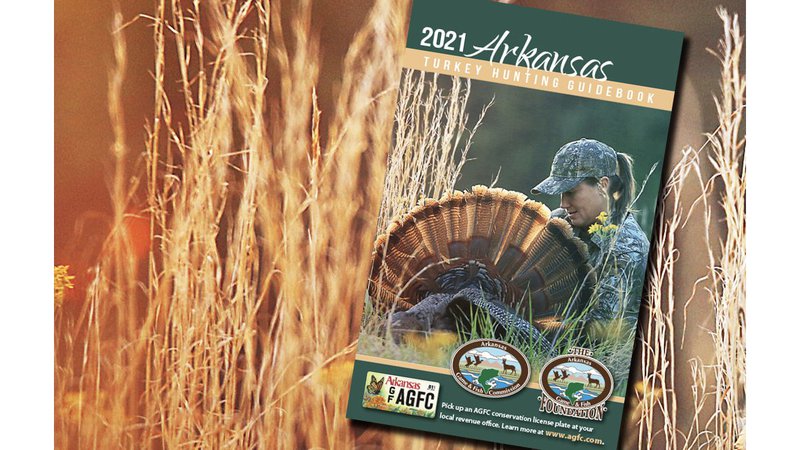
March 17, 2021
Randy Zellers
Assistant Chief of Communications
LITTLE ROCK — With one month until the opening day of Arkansas’s turkey season, the Arkansas Game and Fish Commission is finishing up printing of the 2021 Arkansas Turkey Hunting Guidebook, which contains all regulations for this year’s hunt. The guidebooks will be distributed in the next week, but for those wanting a copy now, a digital download is available at www.agfc.com.
Arkansas turkey hunters will see some major changes in their season this April, all focused to help recover the state’s eastern wild turkey population, which has seen some concerning declines during the last decade.
Jeremy Wood, AGFC wild turkey program coordinator, says the changes are an effort to balance the needs of the turkey population with the desires of hunters. Wood, who’s in his third year with the agency, says he worked closely with biologists who have been on staff at the AGFC for years and combined their knowledge with recent research to develop a plan that enables hunters to still enjoy their sport while regulating turkey harvest to benefit the birds as much as possible.
“The turkey team at the AGFC took a broad look at all of the regulations in the book to see what needed to be updated, done away with or changed to make the best use of research being conducted throughout the Southeast,” Wood said. “We discussed those proposals in several small focus groups composed of a broad spectrum of turkey hunters from around the state. We refined the proposals based on their input, and presented them to the public through regulations surveys last year.”
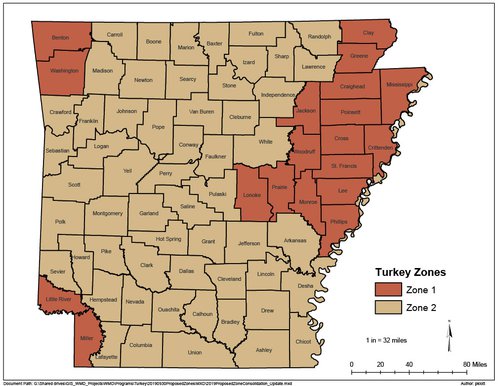
Two main zones
One of the most visible changes is the revamping of the state’s private land turkey hunting zones beginning in the 2021 season. Eighteen turkey zones have been condensed to two, and all zone boundaries will be based on county lines.
“It may seem like a lot, but it really is not a big change once you look at it,” Wood said. “In reality, all those zones really only had two season structures. Now if you know what county you’re in, you know you’re either in Zone 1 or Zone 2.”
Wood says the season structures for the zones are similar to last year, with Zone 1 being a nine-day season with a one-bird bag limit and Zone 2 being a 21-day season with a two-bird bag limit.
“County lines were easy to match up fairly closely with previous boundaries, but we did have a few places where we had to make some decisions on which zone a county should fall under,” Wood said. “In those cases, we always took the more conservative option, hoping any population increases in sections with better habitat would be able to spread into the other portions of the county.”
Wood also stresses that public land hunters remember that each wildlife management area and national wildlife refuge is its own zone with separate regs and zone numbers.
Let Them Lay
This year’s season opener is one of the latest opening days for Arkansas’s turkey season in recent history — April 19. This coincides with the long-term average peak nest initiation (egg-laying) date in Arkansas. The delay is an effort to let more reproduction take place before hunters begin to remove mature gobblers from the landscape.
Although gobblers are sounding off a month or more before the season begins, research has shown the vast majority of hens are not ready to breed that early, and removal of dominant males can negatively impact or delay breeding activity.
“Looking at our brood survey data, only about 40 percent of the hens were bred by opening day,” Wood said. “With this delay, we may see 50 to 60 percent of hens bred. This may improve reproduction and it also means more hens will have started to lay their clutch, and males will increase gobbling as they look for receptive hens again.”
Wood said the delay also will give the birds time to rest between the youth hunt, scheduled for April 10-11, and the regular season opener.
“We have had some hunters complain that the season opener being the day after the youth hunt hurt some gobbling activity,” Wood said. “Many hunters like the Monday opener to spread out pressure, but they want some space between the youth hunt and the regular season. Any hunting pressure has an immediate effect on gobbling activity. Spreading the hunt out will allow some of that gobbling activity to rebound before opening day.”
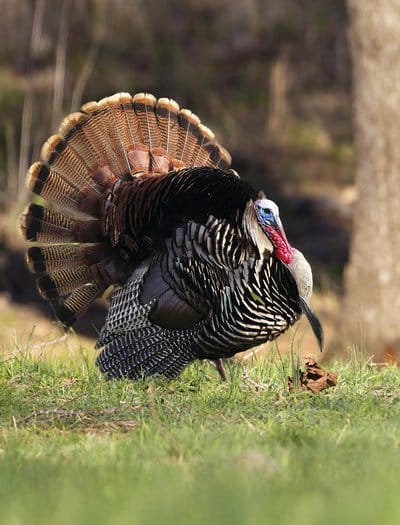
Seven-Day Cooldown
Another new regulation also will distribute some of the hunting success among the growing number of hunters taking up turkey hunting. Much of the state still has a two-turkey seasonal limit, but all hunters will only be able to take one turkey during the first seven days of regular turkey season, regardless of zone.
“Almost 70 percent of the harvest happens between the youth hunt and the first seven days of the season,” Wood said. “Although a very small percentage of hunters actually take two birds in a season, we’re hoping that this restriction will lessen some of the overall pressure in the woods opening week. Turkey behavior is highly linked to hunting pressure, so this will let some hunters get in, enjoy their hunt and get a bird, then be gone for a few days to let the woods cool down a little.”
Wood says similar regulations have been in place in Missouri and South Carolina with good results. He also believes the restriction may help encourage hunters to play more of a mentoring role to young hunters and newcomers.
“If they get a bird in the first few days, this restriction may prompt them to bring someone else to the woods and call for them or help them out in other ways,” Wood said. “Most turkey hunters are hooked on the chase more than the actual harvest, so they can still enjoy being part of someone else’s hunt and help recruit the next generation of hunters.”
No Bearded Hens
Another change hunters will see next season is the prohibition against shooting bearded hens. Though the number of bearded hens harvested each year is small, bearded hens account for as much as 10-12 percent of the female population on average. Wood believes the turkey population may see some benefit at local levels if they are still in the population at season’s end.
“I don’t think it will make a big difference on a statewide or landscape level,” Wood said. “But on a local level you might see a little difference. Every hen that’s out there has the potential to pull off a clutch, and with our recent history of bad hatches, it can’t hurt to have these hens nesting as well.”
Wood says the genetic trait causing a hen to grow a beard may be more prevalent in some areas compared to others. In those local cases, protecting those hens may make a difference in producing the mature gobblers people want to chase.
One and Done on Each WMA
According to Wood about 35 percent of Arkansas’s turkey hunters pursue birds on public land, but only 10 percent of the state’s landmass is open to public hunting. This can make for some crowded woods on opening day of turkey season in some of the state’s more popular wildlife management areas. Not only does that pressure equal less enjoyment for hunters, but it can also severely impact gobbling activity on these WMAs.
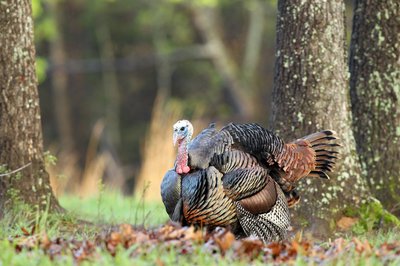
“In reality, we probably won’t see a drop in overall harvest on our WMAs or statewide numbers as a result of this regulation,” Wood said. “What it will do is spread out that harvest among a few more hunters on individual WMAs. The birds that would have been a hunter’s second of the season likely will be harvested by another hunter on the area. The goal is to spread out the pressure a little bit and allow for more hunters to have a higher-quality hunt.”
Wood explains that current limits and seasons are set with the mindset that very few hunters are going to tag out, and a majority of the state’s hunters may not even take their first bird each year.
“Our turkey population simply can’t handle that sort of harvest, and probably never could,” Wood said. “Even if we only had 35,000 hunters pursuing turkeys, the state’s turkey population could never satisfy the idea of 35,000 mature gobblers taken every year. It’s just not sustainable. So our limits and seasons have to be set for what gives the best balance of hunter opportunity and what’s best for the turkey population so we have turkeys to hunt now as well as the future.”
Wood says many factors play into the decline of turkeys taking place across all southeastern states, and season dates and limits are only a small component of the overall picture.
“At the end of the day, limits and season dates can only impact overall population growth so much,” Wood said. “The implementation of the no-jakes rule probably had the largest impact we could have on turkey populations and the overall harvest; there aren’t many more ways to increase gobbler carryover and survival left in the toolbox. We’re trying our best to balance hunting opportunities while providing every opportunity to let these birds do what they need to do before hunters enter the woods. There’s no quick fix, and even these changes aren’t going to produce an immediate rebound in the population. Turkey populations didn’t decline overnight, and they likely aren’t going to rebound overnight either.”
Recent News

Arkansas Wildlife Weekly Fishing Report
Jul. 10, 2025
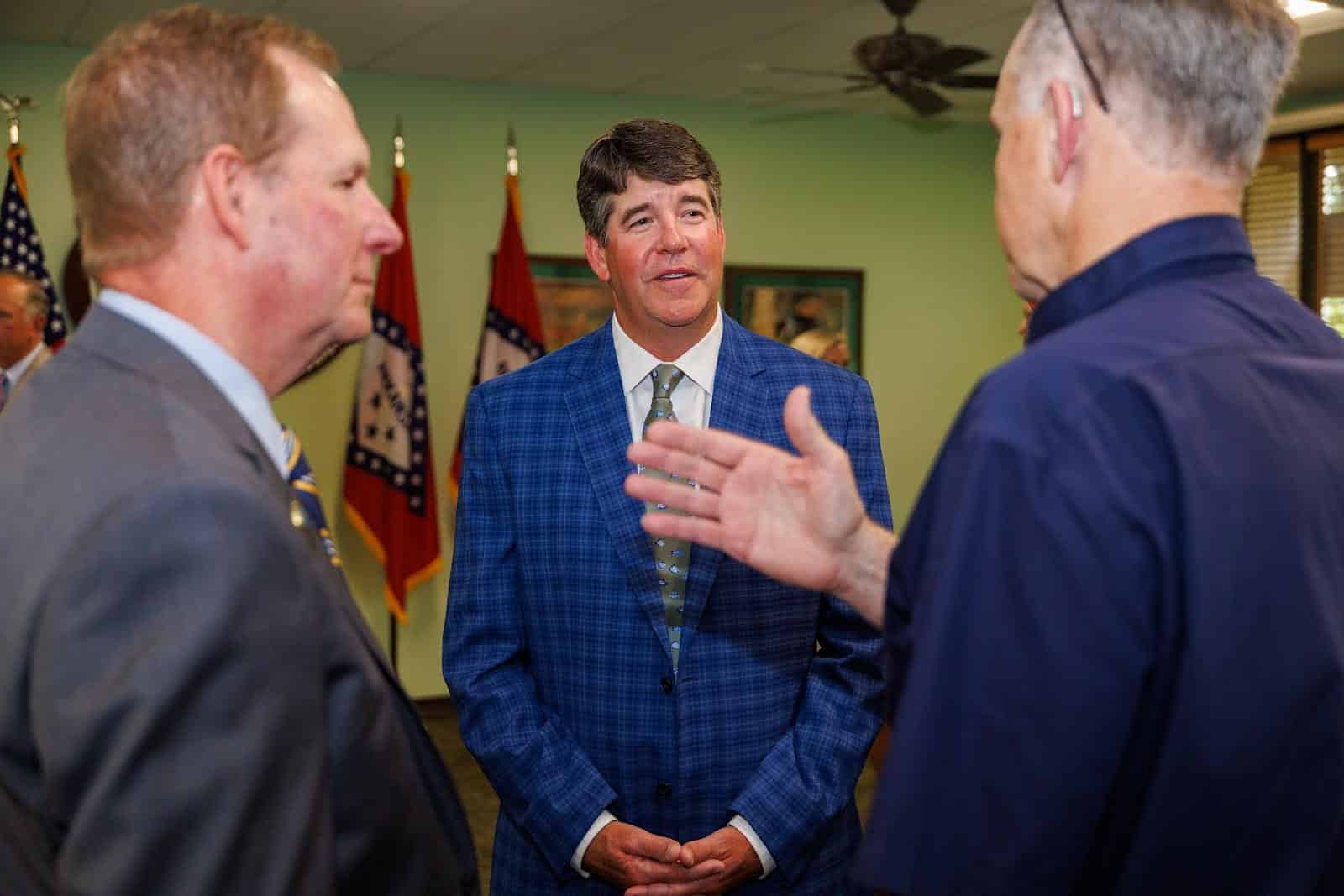
Lonoke aquaculturist named to AGFC
Jul. 10, 2025
Subscribe to Our Weekly Newsletter E-mails
Don’t miss another issue. Sign up now to receive the AGFC Wildlife Weekly Newsletter in your mailbox every Wednesday afternoon (Waterfowl Reports are published weekly during waterfowl season and periodically outside the season). Fishing Reports arrive on Thursdays. Fill in the following fields and hit submit. Thanks, and welcome!
